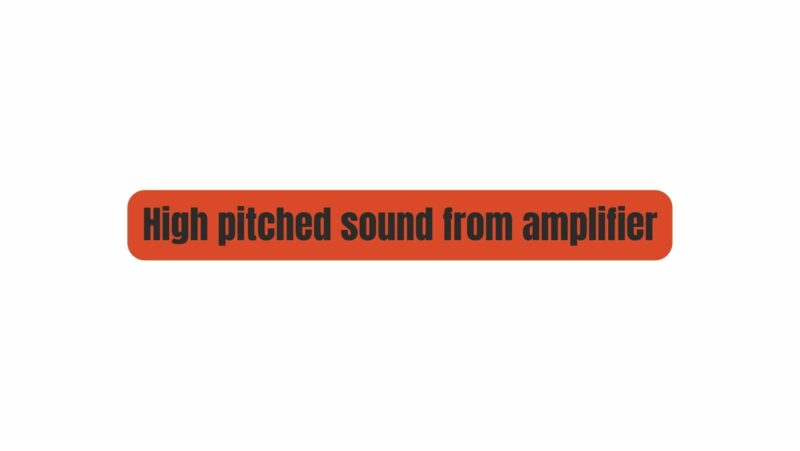Amplifiers are the heart of our auditory experiences, delivering music, speeches, and soundscapes with precision. However, even these trusted companions can sometimes introduce an unwelcome guest – a high-pitched sound. This piercing noise can be both disconcerting and disruptive. In this article, we’ll embark on a journey to understand the causes of high-pitched sounds emanating from amplifiers, explore effective solutions, and provide troubleshooting tips to ensure your amplifier operates silently. By demystifying the high-pitched sound, you can enjoy uninterrupted and harmonious sound quality.
Understanding the Basics: How Amplifiers Work:
Before we dive into the reasons behind high-pitched amplifier noise, let’s establish a foundational understanding of how these audio devices function:
- Amplification Process: Amplifiers take low-level audio signals and magnify them to a level that can drive speakers or headphones, producing audible sound.
- Components of an Amplifier: A typical amplifier consists of preamplification stages, power amplification stages, and a power supply. Each component plays a specific role in shaping the amplifier’s sound.
- Signal Path: An audio signal from your instrument or audio source is processed by the preamp stages, then further amplified by the power stages. The amplified signal is then sent to the output stage, which drives the connected speaker(s).
The Enigmatic High-Pitched Sound: Common Causes:
High-pitched sounds from amplifiers can disrupt your audio experience. Let’s explore some common sources of this enigmatic noise:
- Feedback Loops: High-pitched noises can occur due to feedback loops within the amplifier’s circuitry. These loops may be related to improper grounding, component failures, or circuit design issues, leading to persistent high-pitched noise.
- Electromagnetic Interference (EMI): EMI can infiltrate the amplifier through unshielded cables or poorly insulated components. This interference often manifests as a high-pitched noise, especially when the amplifier is near electronic devices or fluorescent lights.
- Component Issues: Problems with individual components, such as capacitors or resistors, can introduce high-pitched noise into the signal path. These issues can stem from wear, damage, or manufacturing defects.
Addressing High-Pitched Sound: Solutions and Best Practices:
Now that we’ve identified potential causes of high-pitched amplifier noise, let’s explore strategies and best practices to address and prevent them:
- Feedback Loop Mitigation: Investigate the amplifier’s circuitry for signs of feedback loops. Ensure that all components are properly connected and functioning as intended. Consult an experienced technician or amplifier specialist if necessary.
- High-Quality Cables: Invest in high-quality, shielded audio cables for your amplifier setup. Shielded cables help minimize EMI interference and ensure a clean signal path.
- Component Inspection: Periodically inspect the amplifier’s internal components, such as capacitors and resistors, for signs of wear or damage. Replace any faulty components to eliminate high-pitched noise.
- Grounding Optimization: Properly ground your amplifier to a clean, unpainted metal surface. Avoid grounding it to multiple points or using existing grounding that may introduce noise.
- EMI Prevention: Keep your amplifier away from electronic devices and fluorescent lights that may generate EMI. If possible, use power conditioners or surge protectors with EMI filtering to provide clean, stable power to your amplifier.
- Professional Assistance: If the high-pitched noise persists or if you’re uncomfortable with DIY troubleshooting, seek the expertise of a qualified audio technician or amplifier specialist.
Troubleshooting Tips: Addressing High-Pitched Sound:
In addition to the solutions and best practices mentioned above, here are some troubleshooting tips to help you address high-pitched sound issues:
- Isolate the Source: Try to identify the source of the high-pitched noise by gently tapping or pressing on different components while the amplifier is on. Be cautious to avoid electrical shocks. If tapping a specific component affects the noise, it may need attention or replacement.
- Check Grounding: Ensure that your amplifier and audio setup are properly grounded to minimize the risk of noise issues, including high-pitched sound.
- Inspect and Replace Cables: Examine all audio and power cables for damage or wear. Replace any damaged cables to rule out cable-related noise issues.
- Test in Different Environments: If possible, test your amplifier in different locations to determine if the high-pitched noise is related to the environment or specific electrical conditions.
Preventative Measures: Keeping High-Pitched Sound at Bay:
Preventing high-pitched sounds in amplifiers is often more effective than addressing them after they occur. Here are some preventative measures to consider:
- Quality Components: Invest in a high-quality amplifier with reliable components and a robust design. Quality amplifiers are less prone to developing high-pitched noise.
- Proper Grounding: Follow best practices for proper grounding of your entire audio system, including amplifiers and connected equipment, to minimize the risk of noise issues.
- Regular Maintenance: Implement a routine maintenance schedule for your amplifier. Periodically inspect and clean components, check connections, and ensure proper grounding to prevent


